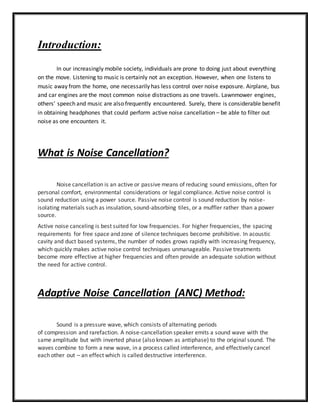
NOISE CANCELATION USING MATLAB
- 1. Introduction: In our increasingly mobile society, individuals are prone to doing just about everything on the move. Listening to music is certainly not an exception. However, when one listens to music away from the home, one necessarily has less control over noise exposure. Airplane, bus and car engines are the most common noise distractions as one travels. Lawnmower engines, others’ speech and music are also frequently encountered. Surely, there is considerable benefit in obtaining headphones that could perform active noise cancellation – be able to filter out noise as one encounters it. What is Noise Cancellation? Noise cancellation is an active or passive means of reducing sound emissions, often for personal comfort, environmental considerations or legal compliance. Active noise control is sound reduction using a power source. Passive noise control is sound reduction by noise- isolating materials such as insulation, sound-absorbing tiles, or a muffler rather than a power source. Active noise canceling is best suited for low frequencies. For higher frequencies, the spacing requirements for free space and zone of silence techniques become prohibitive. In acoustic cavity and duct based systems, the number of nodes grows rapidly with increasing frequency, which quickly makes active noise control techniques unmanageable. Passive treatments become more effective at higher frequencies and often provide an adequate solution without the need for active control. Adaptive Noise Cancellation (ANC) Method: Sound is a pressure wave, which consists of alternating periods of compression and rarefaction. A noise-cancellation speaker emits a sound wave with the same amplitude but with inverted phase (also known as antiphase) to the original sound. The waves combine to form a new wave, in a process called interference, and effectively cancel each other out – an effect which is called destructive interference.
- 2. Fig. 1: Destructive Interference Modern active noise control is generally achieved through the use of analog circuits or digital signal processing. Adaptive algorithms are designed to analyze the waveform of the background noise, then based on the specific algorithm generate a signal that will either phase shift or invert the polarity of the original signal. This inverted signal (in antiphase) is then amplified and a transducer creates a sound wave directly proportional to the amplitude of the original waveform, creating destructive interference. This effectively reduces the volume of the perceivable noise. A noise-cancellation speaker may be co-located with the sound source to be attenuated. In this case it must have the same audio power level as the source of the unwanted sound. Alternatively, the transducer emitting the cancellation signal may be located at the location where sound attenuation is wanted (e.g. the user's ear). This requires a much lower power level for cancellation but is effective only for a single user. Noise cancellation at other locations is more difficult as the three-dimensional wave fronts of the unwanted sound and the cancellation signal could match and create alternating zones of constructive and destructive interference, reducing noise in some spots while doubling noise in others. In small enclosed spaces (e.g. the passenger compartment of a car) global noise reduction can be achieved via multiple speakers and feedback microphones, and measurement of the modal responses of the enclosure. Fig. 2: Graphical depiction of active noise reduction
- 3. Algorithm: There are several algorithms used to calculate the “anti-noise” signal. The Least Mean Square (LMS) algorithm is comprised of two processes – a filtering process producing the output signal and the estimation error, and an adaptive process responsible for the automatic adjustment of filter tap weights. Fig. 3: Sample ANC flowchart with LMS Code in MATLAB: %noise cancellation clc; clear all; order=2; size=2; %time duration of inputs fs=8192; %digital sampling frequency t=[0:1/fs:size]; N=fs*size; %size of inputs f1=35/2; %frequency of voice f2=99/2; %frequency of noise voice=cos(2*pi*f1*t); subplot(4,1,1) plot(t,voice); title('voice (do not have access to)') noise=cos(2*pi*f2*t.^2); %increasing frequency noise
- 4. %noise=.1*rand(1,length(voice)); %white noise primary=voice+noise; subplot(4,1,2) plot(t,primary) title('primary = voice + noise (input1)') ref=noise+.25*rand; %noisy noise subplot(4,1,3) plot(t,ref) title('reference (noisy noise) (input2)'); w=zeros(order,1); mu=.006; for i=1:N-order buffer = ref(i:i+order-1); %current 32 points of reference desired(i) = primary(i)-buffer*w; %dot product reference and coeffs w=w+(buffer.*mu*desired(i)/norm(buffer))';%update coeffs end subplot(4,1,4) plot(t(order+1:N),desired) title('Adaptive output (hopefully it is close to "voice")') Fig. 4: Output in MATLAB
- 5. Application: It can be used in Noise-cancelling headphones which are headphones that reduce unwanted ambient sounds using active noise control. This is distinct from passive headphones which, if they reduce ambient sounds at all, use techniques such as soundproofing. To cancel the lower-frequency portions of the noise, noise-cancelling headphones use active noise control. They incorporate a microphone that measures ambient sound, generate a waveform that is the exact negative of the ambient sound, and mix it with any audio signal the listener desires. Drawbacks: 1. Active noise control requires power, usually supplied by a USB port or a battery that must occasionally be replaced or recharged. 2. Any battery and additional electronics may increase the size and weight of the headphones compared to regular headphones. 3. The noise-cancelling circuitry may reduce audio quality and add high-frequency hiss, though reducing the noise may result in higher perceived audio quality. Conclusion: Noise cancellation makes it possible to listen to music without raising the volume excessively. It can also help a passenger sleep in a noisy vehicle such as an airliner. In the aviation environment, noise-cancelling headphones increase the signal-to-noise ratio significantly more than passive noise attenuating headphones or no headphones, making hearing important information such as safety announcements easier. Noise-cancelling headphones can improve listening enough to completely offset the effect of a distracting concurrent activity.